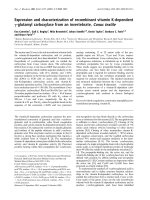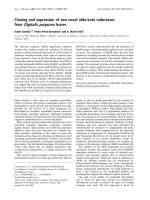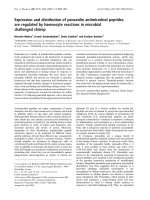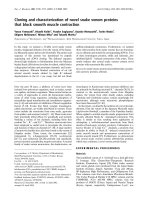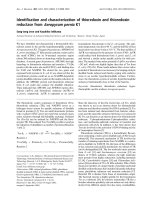Báo cáo y học: "Causes and effects of hyperchloremic acidosis" pps
Bạn đang xem bản rút gọn của tài liệu. Xem và tải ngay bản đầy đủ của tài liệu tại đây (31.67 KB, 2 trang )
Page 1 of 2
(page number not for citation purposes)
Available online />Gunnerson and colleagues [1] found in their retrospective
study that critically ill patients with lactate acidosis had a
higher mortality compared to patients with hyperchloremic
acidosis, whose mortality was not significantly different from
patients with no acidosis. Because of its iatrogenic etiology
the authors commented that it is reassuring that
hyperchloremic acidosis is not associated with an increased
mortality. Previous randomized controlled trials have,
however, generated concerns regarding the adverse effects
of hyperchloremic acidosis associated with rapid isotonic
saline administration. Rapid isotonic saline infusion
predictably results in hyperchloremic acidosis [2]. The
acidosis is due to a reduction in the strong anion gap by an
excessive rise in plasma chloride as well as excessive renal
bicarbonate elimination. In a randomized controlled trial with
a mixed group of patients undergoing major surgery, isotonic
saline infusion was compared to Hartmann’s solution with
6% hetastarch with a balanced electrolyte and glucose
solution. Two-thirds of patients in the isotonic saline group
but none in the balanced fluid group developed
hyperchloremic metabolic acidosis [3]. The hyperchloremic
acidosis was associated with reduced gastric mucosal
perfusion on gastric tonometry. Another randomized double
blind trial of isotonic saline versus lactated Ringer’s in
patients undergoing aortic reconstructive surgery confirmed
this result and the acidosis required interventions like
bicarbonate infusion and was associated with the
application of more blood products [4].
Hyperchloremia was found to have profound effects on
eicosanoid release in renal tissue, leading to vasoconstriction
and a reduction of the glomerular filtration rate [5].
The increased eicosanoid release may also explain the
findings of reduced gastric perfusion in the hyperchloremia
mentioned above [3]. The main adverse effect of saline
induced hyperchloremic acidosis, however, may be the action
that is taken to correct the abnormality. Acidosis is often seen
as a reflection of poor organ perfusion or poor myocardial
function and a negative base excess may prompt the
application of boluses of more saline containing fluids
exacerbating the acidosis, the use of blood products,
escalation of inotrope support and initiation of ventilatory
support [6,7].
The safety of hyperchloremic acidosis has not been
established in prospective studies and in patients with
different types of critical illness. Particularly in critically ill
patients with other co-morbidities like renal disease, more
physiological electrolyte solutions (e.g., Ringers lactate
solution) may be preferable to isotonic saline and a slow fluid
replacement protocol safer than rapid infusions.
Letter
Causes and effects of hyperchloremic acidosis
Michael Eisenhut
Institute of Child Health, University of Liverpool, Eaton Road, Liverpool L12 2AP, United Kingdom
Corresponding author: Michel Eisenhut,
Published: 29 June 2006 Critical Care 2006, 10:413 (doi:10.1186/cc4963)
This article is online at />© 2006 BioMed Central Ltd
See related research by Gunnerson et al., />Authors’ response
John A Kellum and Kyle J Gunnerson
We would like to thank Dr Eisenhut for his insightful
comments regarding our article [1]. Historically, hyper-
chloremic metabolic acidosis has been viewed as a
‘necessary evil’ of volume resuscitation in critically ill patients.
Dr Eisenhut has appropriately included several studies
published in the past 10 years highlighting some of the
adverse effects of this iatrogenic hyperchloremia [2-7]. We
agree with his current comments and have editorialized on
this in the past as well [8].
Not only has hyperchloremia been associated with a variety
of clinical effects cited by Dr Eisenhut, we have also found
various cellular and hemodynamic responses attributed to
the ‘type’ of metabolic acidosis rather than the ‘degree’ of
Page 2 of 2
(page number not for citation purposes)
Critical Care Vol 10 No 3 Eisenhut
acidosis per se. Lipopolysaccharide-stimulated macrophage-
like cells in culture exhibited an augmented inflammatory
response when subjected to hyperchloremic acidosis
whereas hyperlactemia attenuated this response [9]. Hyper-
chloremia also caused hypotension in a cecal ligation and
puncture model of sepsis in the rat; an effect partially
mediated by nitric oxide [10]. Furthermore, in an endotoxin
model of sepsis, decreased survival was noted when normal
saline was used as a resuscitative fluid compared to
Hextend (synthetic colloid dissolved in a balanced salt
solution) [11].
However, clinical studies have not revealed effects of hyper-
chloremic acidosis on outcome. Of course, such studies have
either been observational in nature, small in sample size or
both. Our large, observational study did reveal a trend
showing hyperchloremic metabolic acidosis was worse than
the no metabolic acidosis group; however, it did not reach
statistical significance. Thus, we suspect that the effects of
hyperchloremia, especially when modest, are unlikely to
influence outcome for most patients. However, given that
hyperchloremic acidosis is often iatrogenic, and associated
with morbidity, it should be avoided whenever possible.
Competing interests
The authors declare that they have no competing interests.
References
1. Gunnerson KJ, Saul M, He S, Kellum JA: Lactate versus non-
lactate metabolic acidosis: a retrospective outcome evalua-
tion of critically ill patients. Crit Care 2006, 10:R22.
2. Prough DS, Bidani A: Hyperchloremic metabolic acidosis is a
predictable consequence of intraoperative infusion of 0.9%
saline. Anesthesiology 1999, 90:1247-1249.
3. Wilkes NJ, Woolf R, Mutch M, Mallett SV, Peachey T, Stephens
R, Mythen MG: The effects of balanced versus saline-based
hetastarch and crystalloid solutions on acid-base and elec-
trolyte status and gastric mucosal perfusion in elderly surgi-
cal patients. Anesth Analg 2001, 93:811-816.
4. Waters JH, Gottlieb A, Schoenwald P, Popovich MJ, Sprung J,
Nelson DR: Normal saline versus lactated Ringer’s solution
for intraoperative fluid management in patients undergoing
abdominal aortic aneurysm repair: an outcome study. Anesth
Analg 2001, 93:817-822.
5. Bullivant EMA, Wilcox CS, Welch WJ: Intrarenal vasoconstric-
tion during hyperchloremia: role of thromboxane. Am J
Physiol 1989, 256:152-157.
6. Skellett S, Mayer A, Durward A, Tibby SM, Murdoch IA: Chasing
the base deficit: hyperchloremic acidosis following 0.9%
saline fluid resuscitation. Arch Dis Child 2000, 83:514-516.
7. Brill SA, Stewart TR, Brundage SI, Schreiber MA: Base deficit
does not predict mortality when secondary to hyperchloremic
acidosis. Shock 2002, 17:459-462.
8. Kellum JA: Saline-induced hyperchloremic metabolic acidosis.
Crit Care Med 2002, 30:259-261.
9. Kellum JA, Song M, Li J: Lactic and hydrochloric acids induce
different patterns of inflammatory response in LPS-stimu-
lated RAW 264.7 cells. Am J Physiol Regul Integr Comp Physiol
2004, 286:R686-R692.
10. Kellum JA, Song M, Venkataraman R: Effects of hyperchloremic
acidosis on arterial pressure and circulating inflammatory
molecules in experimental sepsis. Chest 2004, 125:243-248.
11. Kellum JA: Fluid resuscitation and hyperchloremic acidosis in
experimental sepsis: improved short-term survival and acid-
base balance with Hextend compared with saline. Crit Care
Med 2002, 30:300-305.





